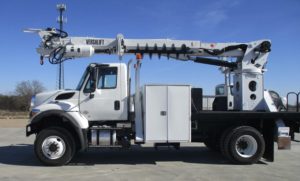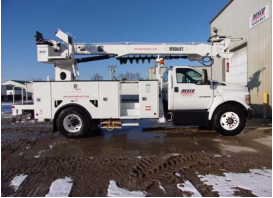Whether you’re new to digger derricks or have years of field experience, questions come up – about safety, specs, service, and what to look for when choosing the right equipment. To help you get clear, straightforward answers, we’ve gathered the most common questions we hear from customers, operators, and fleet managers.
In this FAQ, you’ll find practical information about how digger derricks work, how to choose the right one, and how to keep it running safely and efficiently. If you’re looking to get the most from your investment – or just want to better understand the equipment you rely on every day – you’re in the right place.
Q1: What is a digger derrick, and what is it used for?
A digger derrick is a powerful, truck-mounted machine designed for lifting, drilling, and setting utility poles and other structural components. It’s one of the most versatile tools in the utility and telecommunications industries, combining several key functions into a single piece of equipment.
The core components of a digger derrick typically include:
- A rotating boom with lifting capability
- An auger for drilling holes in various soil types
- A winch or sheave for hoisting materials like poles or transformers
- Outriggers for stability during operation
Primary applications include:
- Setting power and telephone poles
- Digging holes for construction footings or anchors
- Lifting and positioning heavy utility components
- Supporting underground utility work and right-of-way clearing
Digger derricks are used daily by electric utility companies, telecom contractors, infrastructure crews, and municipal service providers, especially when working in remote or challenging environments.
Whether you’re operating in open fields or navigating tight urban job sites, a digger derrick allows you to dig, lift, and install – all without switching equipment. That’s what makes it such a critical asset in modern utility fleets.
Q2: What should I consider when choosing a digger derrick?
Choosing the right digger derrick depends on the type of work you do, how often you do it, and the environments you operate in. While all digger derricks are designed to drill, lift, and set poles, different models offer different capabilities – and matching those to your job requirements is key to long-term performance and safety.
Here are some of the most important factors to consider:
- Lifting capacity: How heavy are the materials you’ll be handling, and at what distance from the truck?
- Boom reach and sheave height: Do you need to lift poles vertically into place or reach across obstacles?
- Auger torque and digging radius: What kind of soil or ground conditions will you encounter, and how deep or wide do you need to drill?
- Chassis type and mobility: Will you be working in tight urban spaces, off-road environments, or both?
- Frequency of use: Are you using the equipment daily, or is it part of a mixed-use fleet?
It’s also worth thinking about crew experience, customization options, and future needs. Choosing a model that’s slightly more capable than your current baseline can give you more flexibility as project scopes evolve.
For a more detailed breakdown of how to match specifications to your application, see our full guide: How to Choose the Right Digger Derrick for Your Job.

Q3: What are load charts, and why do they matter?
Load charts are one of the most important tools for operating a digger derrick safely and effectively. They show how much weight the equipment can lift at different boom angles, extensions, and load radii – helping you stay within the machine’s rated limits during every lift.
Because lifting capacity changes based on how far out and how high you’re reaching, a digger derrick that can handle a heavy load up close might not be able to lift the same weight at full extension. That’s where the load chart comes in. It gives the operator a clear guide to what the machine can safely handle in different positions.
Using the load chart correctly helps you:
- Avoid overloading and damaging the equipment
- Prevent accidents caused by tipping or structural stress
- Make faster and more confident decisions on the job site
Most load charts are located on or near the control station of the digger derrick, and all operators should be trained in how to read and apply them. Understanding your load chart isn’t just a best practice – it’s a critical part of safe and efficient operation.
Q4: How often should a digger derrick be inspected and maintained?
To keep your digger derrick running safely and efficiently, it’s important to follow a regular inspection and maintenance routine. How often you service the equipment depends on how much it’s used, but in general, a mix of daily checks and scheduled maintenance is the best way to prevent costly breakdowns and extend the machine’s lifespan.
Here’s a basic outline of what that looks like:
- Daily: Operators should perform a walkaround before each shift. This includes checking for leaks, inspecting hoses and outriggers, testing boom movement, and verifying warning lights.
- Weekly or Monthly: Conduct deeper inspections that include torque checks, fluid levels, lubrication points, and wear on augers and mounting points.
- Scheduled maintenance: Follow the manufacturer’s service intervals for hydraulic systems, filters, electrical checks, and structural inspections.
Keeping a maintenance log and addressing issues early can help you avoid bigger repairs later on. It also ensures your digger derrick stays compliant with safety standards and warranty requirements.
Q5: Can I use a digger derrick in cold weather or extreme climates?
Yes – digger derricks are built to handle tough conditions, including cold weather, heat, and rough terrain. But to keep the equipment running smoothly and safely in extreme climates, it’s important to take a few extra precautions.
Here’s what to consider in cold weather:
- Use the right fluids: Make sure hydraulic oil, engine oil, and grease are rated for low temperatures. Cold-thickened fluids can reduce system performance.
- Inspect seals and hoses: Rubber components can become brittle in freezing conditions, increasing the risk of cracks or leaks.
- Warm-up time: Let the engine and hydraulics reach proper operating temperature before running the boom or auger.
- Avoid drilling in frozen ground: Unless the equipment and auger are designed for it, frozen soil can damage components and wear down cutting edges quickly.
In hot or dusty conditions:
- Check cooling systems: Overheating can damage hydraulic components and engines, especially under heavy load.
- Clean air filters regularly: Dust and debris can reduce airflow and clog systems.
- Inspect tires and hoses more frequently: Heat and UV exposure can accelerate wear.
With the right adjustments and maintenance routines, your digger derrick can perform reliably in almost any climate. Always refer to the manufacturer’s recommendations for temperature-specific fluids and best practices.
Explore our full range of digger derricks here.
Q6: What is the average lifespan of a digger derrick?
The typical lifespan of a digger derrick depends on how it’s used, maintained, and stored. Factors that influence longevity include:
- Usage intensity: Daily, high-demand utility work wears components faster than occasional light-duty use.
- Operating environment: Harsh weather, rough terrain, or corrosive conditions can reduce lifespan if not managed properly.
- Maintenance routines: Regular servicing, inspections, and the use of OEM parts help prevent premature wear and unexpected breakdowns.
- Operator habits: Machines that are used responsibly and within their rated limits tend to last significantly longer.
If you want to get the most out of your investment, it’s important to follow a proactive maintenance schedule and train your operators on proper use and inspection. For more detailed tips, see our related guide: How to Expand the Lifespan of Your Digger Derrick.
Q7: Is there a warranty on Versalift digger derricks?
Yes, all digger derricks manufactured by Versalift come with a standard manufacturer’s warranty that covers both parts and structural components. This includes:
- One-year warranty on parts – covering defects in materials and workmanship
- Lifetime warranty on structural components – providing long-term assurance on the integrity of key load-bearing elements
For added protection, Versalift also offers the option to purchase an extended warranty. This option is available only to the original owner at the time of purchase and is non-transferable if the unit changes ownership.
This warranty structure is part of Versalift’s commitment to quality and reliability – helping you protect your investment and reduce long-term risk in the field.
Q8: What kind of training or certifications do operators need?
Operating a digger derrick requires more than just experience – it requires proper training to ensure safety, efficiency, and compliance with industry standards. Because digger derricks are powerful machines used for lifting, drilling, and setting poles, operators need to be fully prepared to handle both the equipment and the jobsite environment.
Here’s what’s typically expected:
- OSHA compliance: In the U.S., employers are responsible for ensuring that digger derrick operators are trained according to Occupational Safety and Health Administration (OSHA) standards.
- Equipment-specific training: Operators should be trained on the exact make and model they’ll be using, including load charts, control systems, and safety features.
- Hands-on instruction: Practical experience is essential. Many companies require supervised field training before an operator is cleared to work independently.
- Refresher training: Best practice is to provide periodic retraining, especially when regulations change or when new equipment is introduced.
Some companies also require third-party certification, depending on the industry or the type of work being performed (for example, utility work near high-voltage lines).
Even with built-in safety features, the most important factor in preventing accidents and equipment damage is a well-trained operator.
Still have questions?
If you didn’t find the answer you were looking for, we’re here to help. Whether you’re considering your first digger derrick or managing a full fleet, our team is ready to provide the guidance and technical support you need.

